通配符 或 怎么濃
How long could you wait to brew espresso after grinding? Ask a barista, any barista, and I suspect their answer is immediately or within a few minutes. The common knowledge on coffee grounds freshness is that after 30 minutes or so, coffee grounds go stale. Even if stored, the common knowledge is that coffee grounds still go stale (the length of freshness is not well defined). Is that always true?
磨碎后您要等多久才能煮濃咖啡? 問一個咖啡師,任何咖啡師,我懷疑他們的回答是立即或在幾分鐘之內。 關于咖啡渣新鮮度的常識是,大約30分鐘后,咖啡渣變陳舊。 即使已存儲,通常的知識是咖啡渣仍然過時(新鮮度的長度定義不清)。 總是這樣嗎?
My experience with the staccato shot has led me to believe that the common thinking on coffee grounds freshness is not correct. I have looked for supporting data, and there is not much, probably because it seems so obvious. So I will share my experience and my data which suggests that if stored in an airtight container, coffee grounds can be used for at least a few days without losing flavor. The past few months, I’ve been storing my the refrigerator for my spicy shots, but I have also looked back at coffee grounds before I refrigerated them regularly.
我使用斷斷續續拍攝的經驗使我相信,關于咖啡渣新鮮度的一般想法是不正確的。 我一直在尋找支持數據,但數量不多,可能是因為它看起來如此明顯。 因此,我將分享我的經驗和數據,這些數據和建議表明,如果將咖啡渣保存在密閉的容器中,則至少可以使用幾天,而不會失去風味。 在過去的幾個月中,我一直在存放冰箱以存放辛辣的食物,但是在我定期對咖啡渣進行冷藏之前,我也回過頭來。
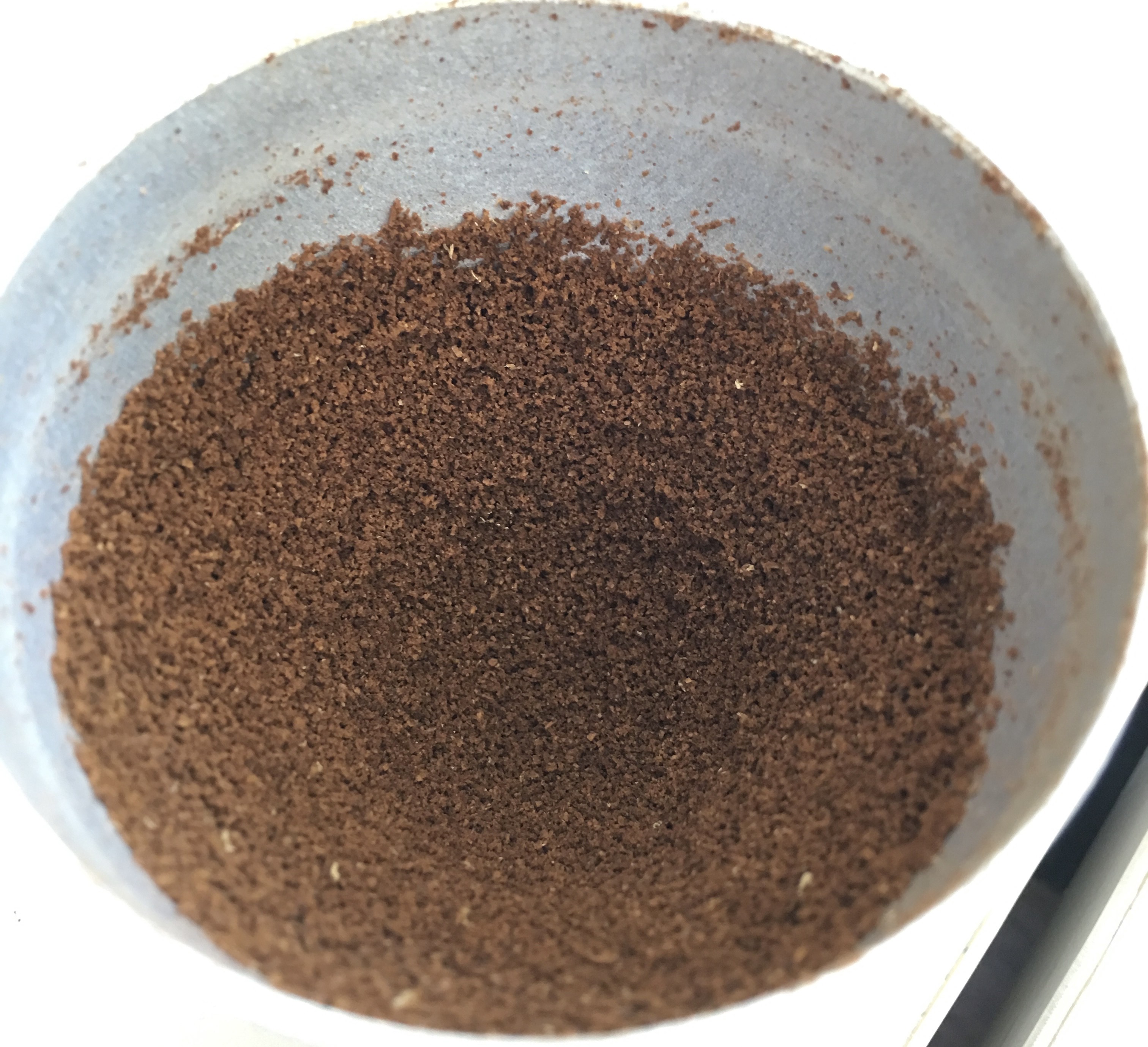
以往的經驗 (Previous Experience)
For awhile, I was grinding fresh, but that changed when I started to develop the staccato espresso shot. Grinding and sifting for every shot was tedious, so I would grind enough coffee for a few shots, and I would sift and store the coffee in air tight containers.
有一段時間,我一直在磨新鮮,但是當我開始制作斷斷續續的意式特濃咖啡時,情況發生了變化。 每次研磨和篩分都很繁瑣,因此我要研磨足夠的咖啡以進行幾次注射,然后將咖啡篩分并儲存在密封的容器中。
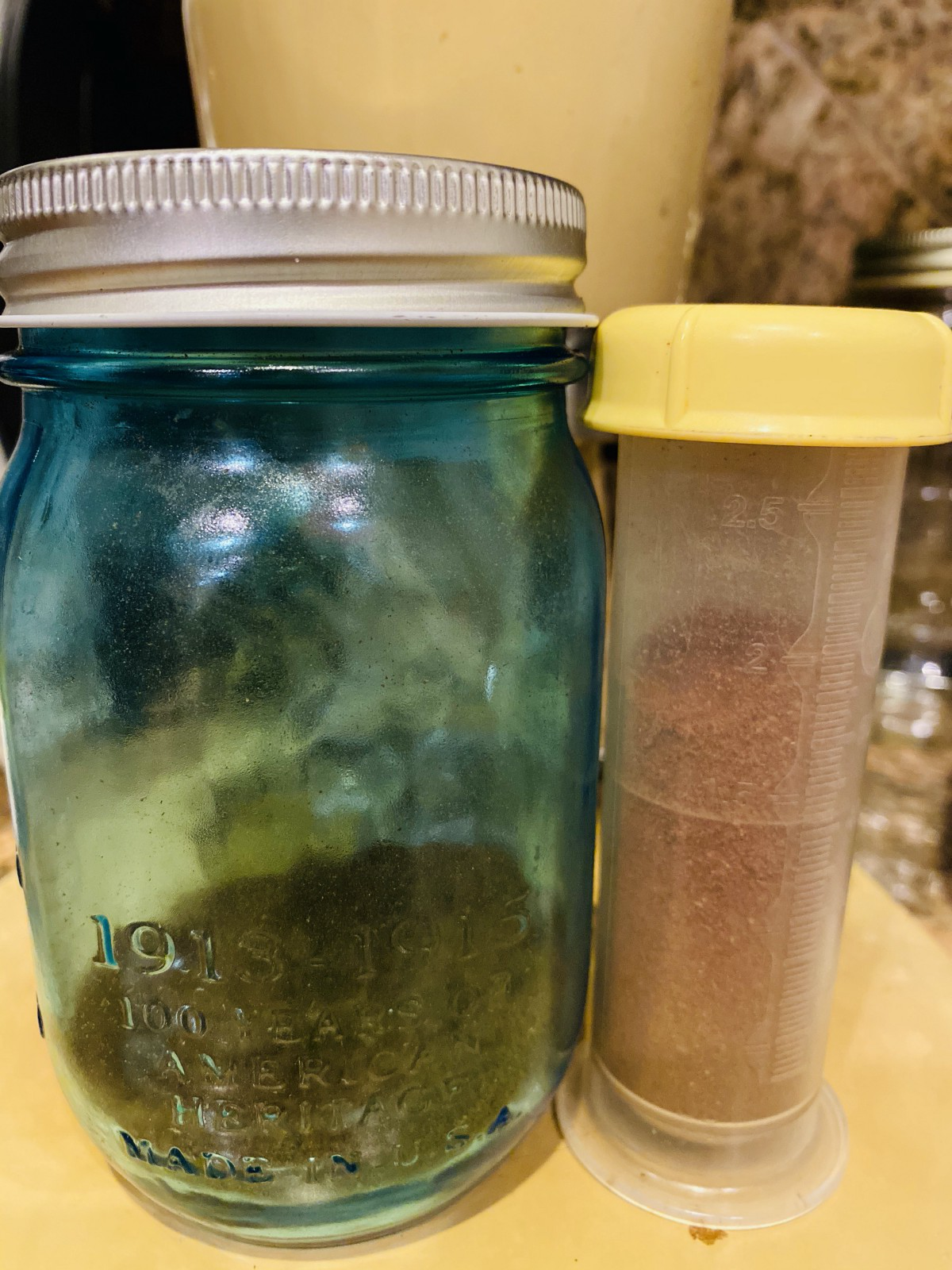
I found such a benefit to the containers that I would grind coffee and store it in them even if I wasn’t going to sift it. To make my process more efficient, I would grind in the morning, and an hour later, I would sift the grounds on my way to work. The time between grind and brew started extending.
我發現這種容器有很大的好處,即使我不想篩分,我也可以將咖啡研磨并儲存在容器中。 為了使我的過程更有效率,我會在早上磨碎,一個小時后,我會篩選上班方式。 研磨和沖泡之間的時間開始延長。
I also am lazy when it comes to certain things, and I have on occasion left grinds in sealed containers for multiple days. I didn’t notice much of a degradation in taste.
當涉及到某些事情時,我也很懶惰,有時我會在密封的容器中放多個研磨物。 我沒有注意到味道的降低。
數據采集 (Data Collection)
I started recording grind date and time only when I started recording bean temperature at grind. I was doing experiments with hot and cold beans at grind, and I figured I would keep track of it. I typically would grind four shots at a time, and it would take me 2 to 4 days depending on how much time I had to drink fancy coffee.
我只有在開始記錄研磨時的豆溫度時才開始記錄研磨日期和時間。 我在研磨時對熱豆和冷豆進行了實驗,我想我會一直跟蹤它。 我通常一次打四針,這需要2到4天,具體取決于我要花多少時間喝花式咖啡。
I started looking at that data to see if I could tell me if there was any change in taste or extraction yield. When I didn’t see a change (as seen further down), I did a few longer experiments where I would grind 8 shots worth of coffee to drink over a week. I also went back to previous data and labeled estimated grind dates based on when the grounds were sifted, which I recorded separately.
我開始查看這些數據,看是否可以告訴我口味或提取率是否有變化。 當我沒有看到變化時(更進一步),我進行了一些更長的實驗,在一周的時間里,我將研磨8杯咖啡。 我還回到了以前的數據,并根據篩選的時間標記了估計的研磨日期,我分別進行了記錄。
Most of these shots were using home roasted beans that were 1 to 1:30 minutes past the first crack. I ground the beans on either a Rok grinder or a Lime grinder, and this data is from shots pulled on a Kim Express. Additionally, if one thinks having a better grinder is more important, I would refer them to this work where I used a blade grinder and a sifter to make a good shot of espresso which suggests a sifter equalizes the field of grinders.
這些鏡頭中的大多數使用的是經過第一次烘烤1至1:30分鐘的家用烤豆。 我在Rok磨豆機或Lime磨豆機上將豆磨碎,這些數據來自在Kim Express上拍攝的照片。 此外,如果有人認為擁有一個更好的研磨機更為重要,那么我會推薦他們去做這項工作,在該工作中,我使用了刀片研磨機和篩分機對意式濃縮咖啡進行了很好的拍攝,這表明篩分機可以使研磨機的領域更加均衡。
績效指標 (Metrics of Performance)
I used two metrics for evaluating the differences between shots: Final Score and Coffee Extraction.
我使用了兩個指標來評估鏡頭之間的差異: 最終得分和咖啡提取 。
Final score is the average of a scorecard of 7 metrics (Sharp, Rich, Syrup, Sweet, Sour, Bitter, and Aftertaste). These scores were subjective, of course, but they were calibrated to my tastes and helped me improve my shots. There is some variation in the scores. My aim was to be consistent for each metric, but some times the granularity was difficult and affected the final score.
最終分數是7個指標(“鋒利”,“豐富”,“糖漿”,“甜”,“酸”,“苦”和“回味”)的記分卡的平均值。 這些分數固然是主觀的,但是根據我的口味進行了校準,并幫助我改善了投籃。 分數有所不同。 我的目標是使每個指標保持一致,但有時粒度很困難并且影響最終分數。
Total Dissolved Solids (TDS) is measured using a refractometer, and this number is used to determine the percentage of coffee extracted into the cup in combined with the output weight of the shot and the input weight of the coffee, called Extraction Yield (EY).
使用折光儀測量總溶解固體(TDS),此數字用于確定提取到杯子中的咖啡的百分比以及小球的輸出重量和咖啡的輸入重量,稱為提取率(EY) 。
數據發現 (Data Findings)
First, looking at the data, I plotted all the data, and I didn’t notice anything. There was definitely variation over the days in taste (Final Score) and EY, but I didn’t see any patterns. I will note that I stored most of these grounds in the refrigerator due to spicy grinding, but I haven’t noticed a taste degradation for grounds stored at room temperature for a day or two.
首先,查看數據,我繪制了所有數據,但沒有發現任何東西。 這些天的口味(最終得分)和EY肯定有差異,但是我沒有看到任何規律。 我會注意到,由于辛辣研磨 ,我將大部分這些碎屑儲存在冰箱中,但是我并沒有注意到室溫下存放一兩天的碎屑的味道會下降。
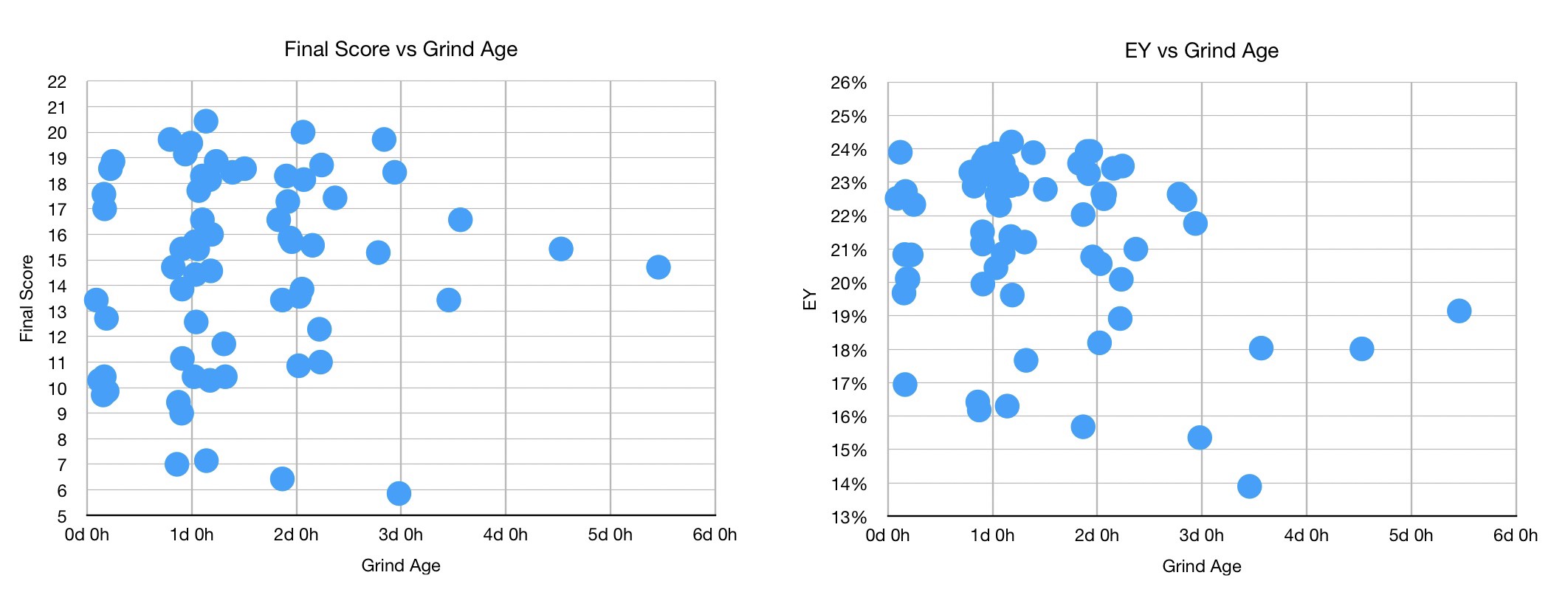
So I broke it down by roast, and I shorted the time window to 3 days maximum. Again, each roast seemed not to degrade over time. There was variations within the day related to changes in some experiments I was running, but there was not a trend.
因此,我將其分解為烤肉,并將時間窗口縮短至最長3天。 同樣,每次烘烤似乎都不會隨著時間而降低。 當天發生的變化與我進行的某些實驗的變化有關,但沒有趨勢。
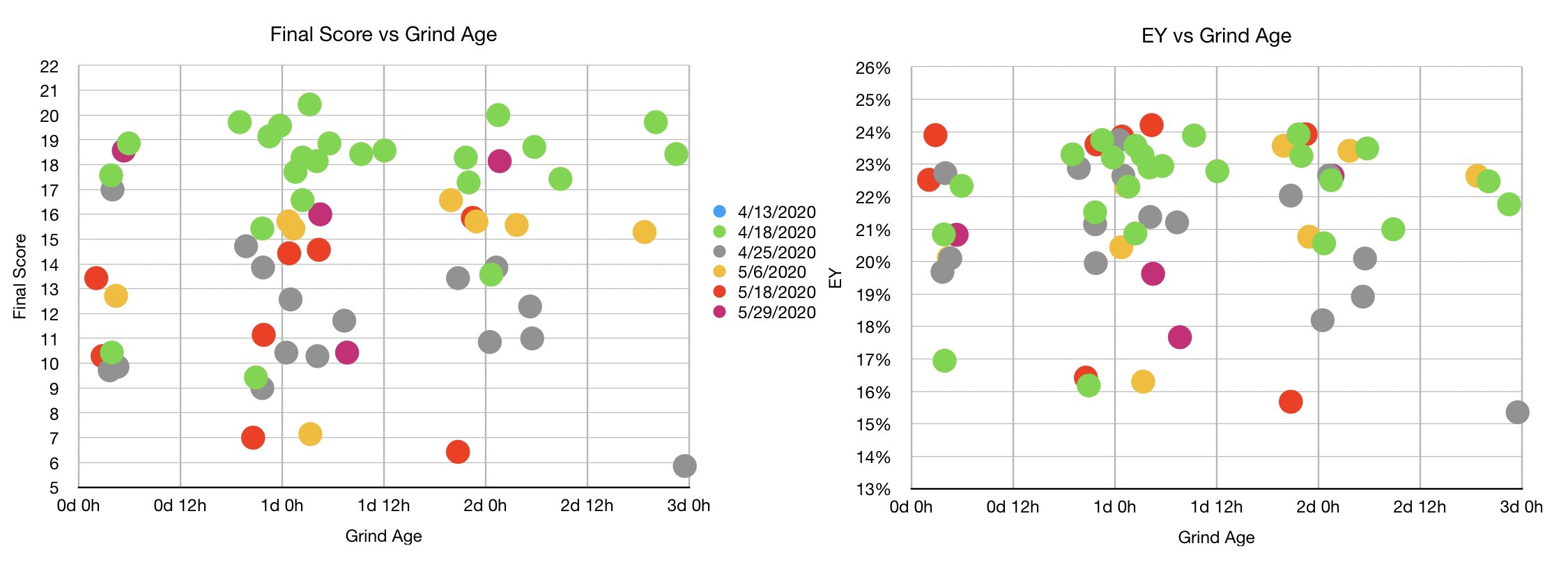
I decided to simply the data. I cut it in half because half of the data had a grind age of less than 1 day and 4 hours. I wanted to do within a day and greater than a day, but it wasn’t an even cut. In this split, there were some differences, but none of the distribution differences were statistically significant.
我決定簡單地處理數據。 我將其減少了一半,因為一半的數據的磨合時間少于1天4個小時。 我想在一天之內完成一天以上的工作,但這并不是一成不變的。 在此拆分中,存在一些差異,但所有分布差異均無統計學意義。
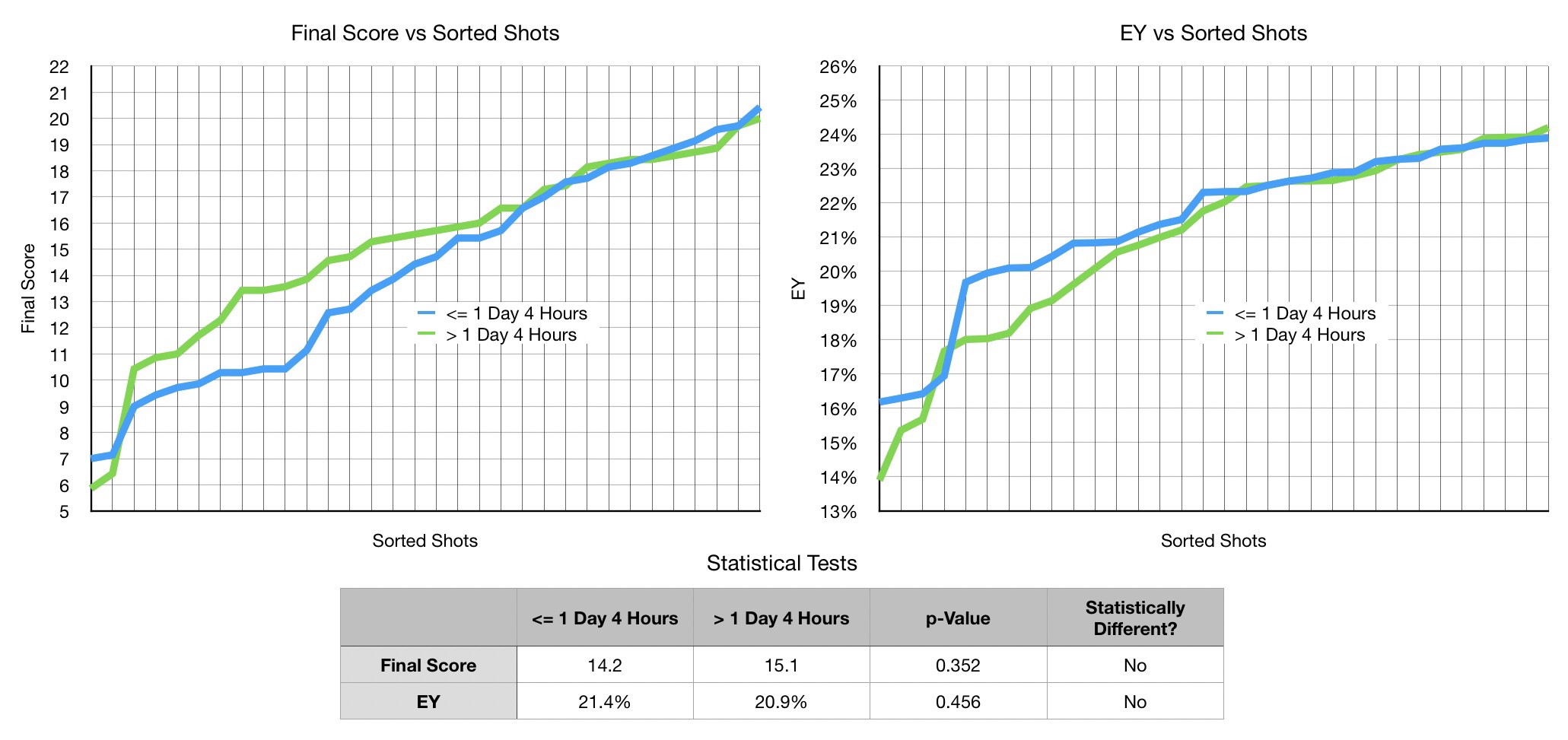
I typically would grind enough for four 18g shots, and I wanted to test the grinds over a longer window than previous. I did this with two roasts, and I saw variations, but not trends. The grounds were also stored in the refrigerator which could have contributed to their taste staying fresh.
我通常會打夠四個18g的鏡頭,而且我想在比以前更長的窗口上測試這些鏡頭。 我進行了兩次燒烤,發現變化,但沒有趨勢。 地面也被存儲在冰箱中,這可能有助于保持口感新鮮。
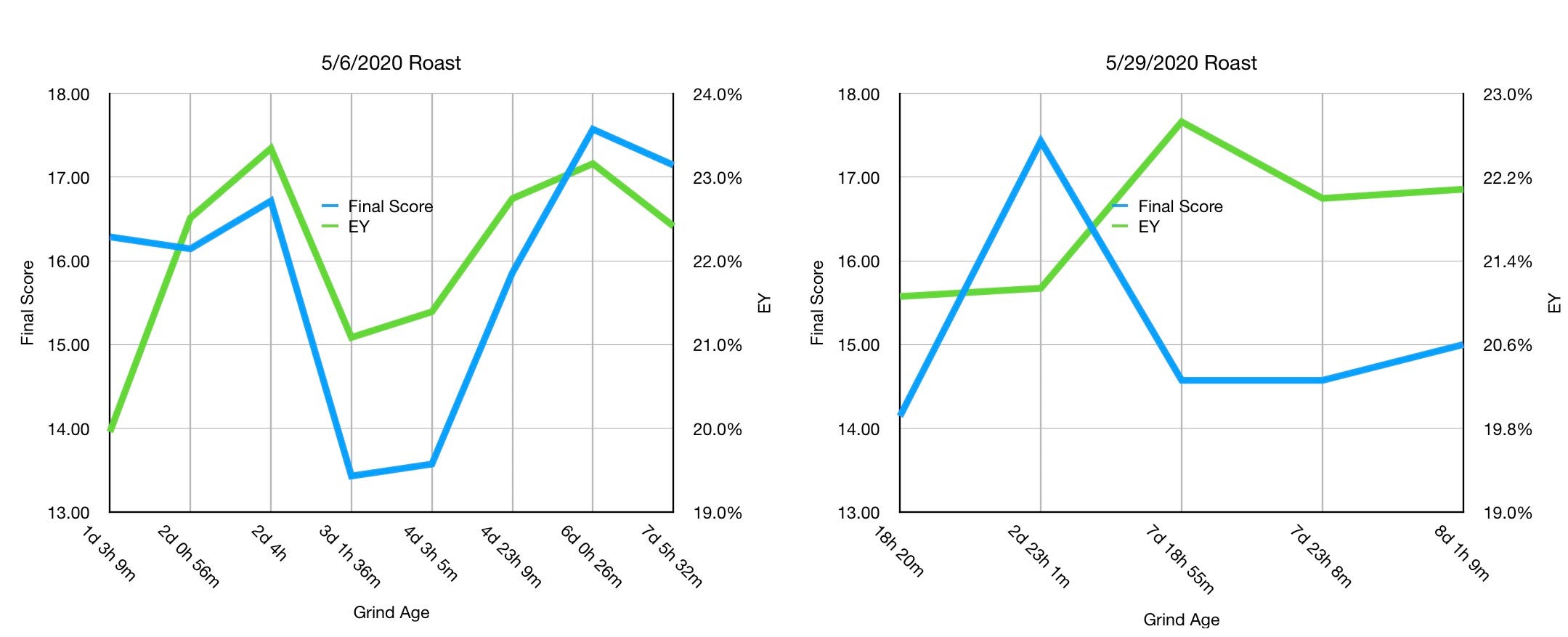
射擊時間 (Shot Time)
Shot time also seemed unaffected by grind age. Across the different roasts, the shot time stays pretty consistent, and I didn’t see any trends.
射門時間似乎也不受年齡的影響。 在不同的烘烤中,射擊時間保持一致,我沒有看到任何趨勢。

更多數據 (More Data)
I pulled 359 shots that I have grind time and time of the shot, but with the wealth of data comes the difficulty of trying to make sense of it. So I first plotted it as a scatter plot. No trend is apparent.
我抽出了359張我一直在努力拍攝的照片,但隨著大量數據的出現,很難理解它。 因此,我首先將其繪制為散點圖。 沒有趨勢是明顯的。

Then, I plotted box plots, and it seems the Final Score or taste improves, but I suspect that improvement is due to improving shot parameters. Also, the distributions are very wide due to the shots being across different roasts and techniques. The is a slight shift in median score, the distribution still stays pretty similar.
然后,我繪制了箱形圖,似乎最終得分或味道有所改善,但我懷疑這種改善是由于改善了擊球參數。 另外,由于鏡頭是通過不同的烘烤和技術進行的,因此分布非常廣泛。 中位數得分略有變化,分布仍然保持相似。

To extract learning, I normalized (Z-norm) the data by roast. For each roast, I calculated the mean and standard deviation (std). Then, for each metric, per each roast, I made the normalized data by this equation: X_norm = (X – Roast_mean)/Roast_std. If there was a trend due to grind age, it should be clear as a change of the normalized distribution.
為了提取學習內容,我通過烘烤對數據進行了標準化(Z范數)。 對于每個烘烤,我計算了平均值和標準偏差(std)。 然后,對于每個度量標準,每個烘烤,我通過以下等式制作歸一化數據:X_norm =(X-Roast_mean)/ Roast_std。 如果存在由于磨削年齡引起的趨勢,則應將其歸一化為正態分布的變化。

As a scatter plot, there doesn’t seem to be much of a change, so let’s look at box plots below. For Regular shots, Final Score stays about the same while EY increases a little bit.
作為散點圖,似乎變化不大,所以讓我們看一下下面的箱形圖。 對于常規拍攝,最終得分保持不變,而EY有所提高。

For Staccato shots, there is not a trend for any of the metrics. 0 in this case means the mean score while positive is higher than the mean, and negative is lower than th emean.
對于斷音拍攝,任何指標都沒有趨勢。 在這種情況下,0表示平均值,而正數高于平均值,而負數低于平均值。
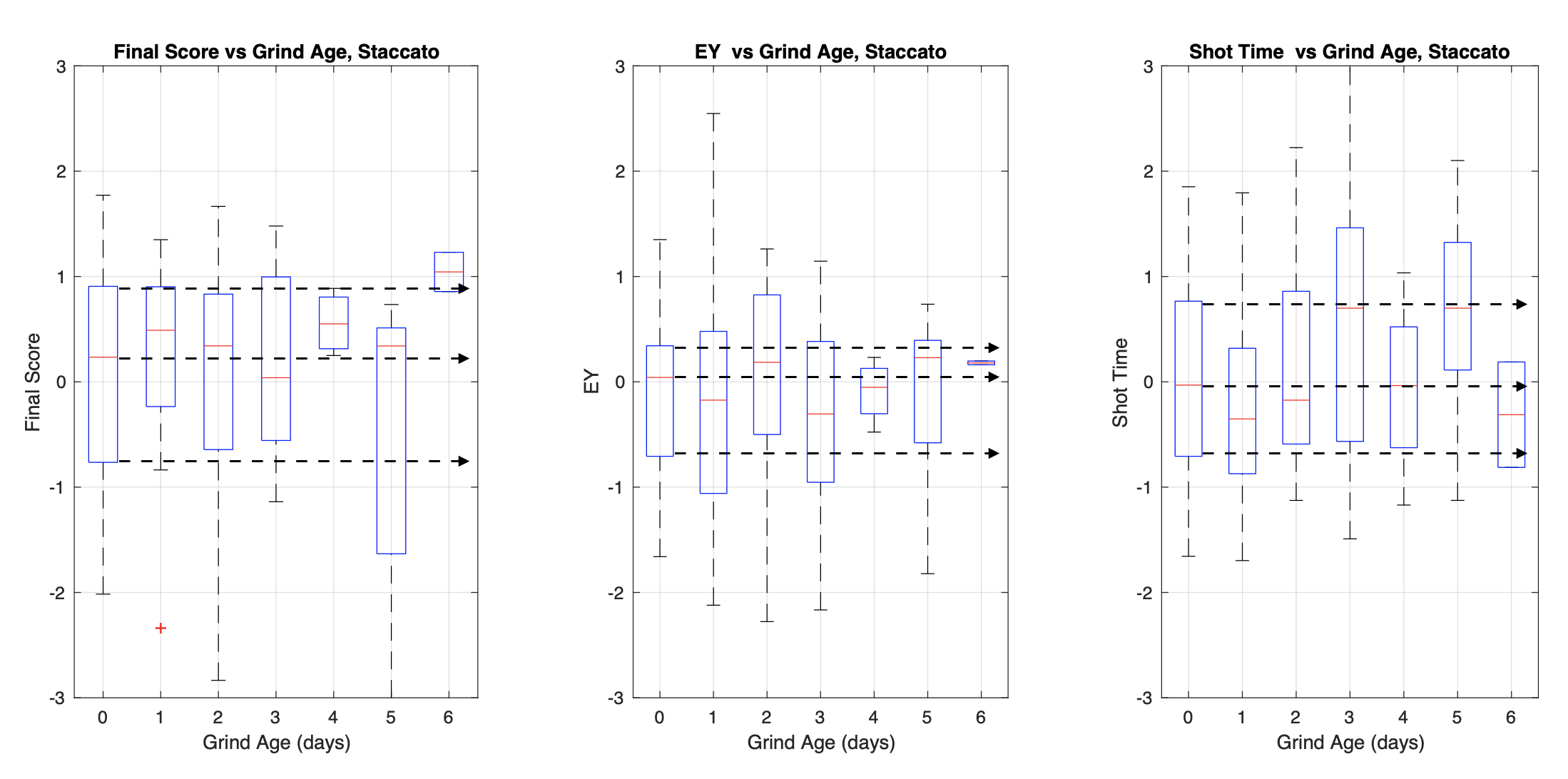
After a suspicion that grind age didn’t matter as much as has been suggested, I looked through as much data as I could find. I didn’t find any trends positive or negative between grind age and multiple metrics (Final Score (taste), EY, or shot time). The main caveat of ground coffee losing taste is most likely based on leaving it exposed to air for a period of time, but at least from my experience, grind more less often has not had a negative impact to my espresso experience.
在懷疑磨削年齡并不像所建議的那樣重要之后,我瀏覽了盡可能多的數據。 在年齡和多項指標(最終得分(口味),安永或出手時間)之間,我沒有發現任何積極或消極的趨勢。 磨碎咖啡失味的主要警告很可能是由于將其暴露于空氣中一段時間??,但至少從我的經驗來看,減少磨碎次數對我的濃縮咖啡體驗沒有負面影響。
If you like, follow me on Twitter and YouTube where I post videos of espresso shots on different machines and espresso related stuff. You can also find me on LinkedIn.
如果您愿意,請在Twitter和YouTube上關注我,在這里我會在不同的機器上發布濃縮咖啡的視頻以及與濃縮咖啡相關的內容。 您也可以在LinkedIn上找到我。
我的進一步閱讀: (Further readings of mine:)
Deconstructed Coffee: Split Roasting, Grinding, and Layering for Better Espresso
解構后的咖啡:焙炒,研磨和分層,以獲得更濃的意式濃縮咖啡
Pre-infusion for Espresso: Visual Cues for Better Espresso
特濃咖啡的預輸注:視覺提示可提供更好的特濃咖啡
The Shape of Coffee
咖啡的形狀
To Stir or To Swirl: Better Espresso Experience
攪拌或旋流:更好的意式濃縮咖啡體驗
Spicy Espresso: Grind Hot, Tamp Cold for Better Coffee
香濃意式特濃咖啡:磨碎熱,搗碎冷可制得更好的咖啡
Staccato Espresso: Leveling Up Espresso
Staccato意式濃縮咖啡:升級意式濃縮咖啡
Improving Espresso with Paper Filters
使用濾紙器改善意式濃縮咖啡
Coffee Solubility in Espresso: An Initial Study
濃咖啡中的咖啡溶解度:初步研究
Staccato Tamping: Improving Espresso without a Sifter
Staccato搗固:無需篩分器即可提高濃咖啡
Espresso Simulation: First Steps in Computer Models
濃縮咖啡模擬:計算機模型的第一步
Pressure Pulsing for Better Espresso
壓力脈沖使咖啡更濃
Coffee Data Sheet
咖啡數據表
Artisan coffee is overprice
工匠咖啡價格過高
The Tale of the Stolen Espresso Machine
被盜咖啡機的故事
Espresso filter analysis
濃縮咖啡過濾器分析
Portable Espresso: A Guide
便攜式意式濃縮咖啡:指南
Kruve Sifter: An Analysis
Kruve Sifter:分析
翻譯自: https://towardsdatascience.com/coffee-grounds-freshness-for-espresso-78a447f84fcd
通配符 或 怎么濃
本文來自互聯網用戶投稿,該文觀點僅代表作者本人,不代表本站立場。本站僅提供信息存儲空間服務,不擁有所有權,不承擔相關法律責任。 如若轉載,請注明出處:http://www.pswp.cn/news/389529.shtml 繁體地址,請注明出處:http://hk.pswp.cn/news/389529.shtml 英文地址,請注明出處:http://en.pswp.cn/news/389529.shtml
如若內容造成侵權/違法違規/事實不符,請聯系多彩編程網進行投訴反饋email:809451989@qq.com,一經查實,立即刪除!





_主成分分析技巧)




![bzoj1095 [ZJOI2007]Hide 捉迷藏](http://pic.xiahunao.cn/bzoj1095 [ZJOI2007]Hide 捉迷藏)




思想及實現)


